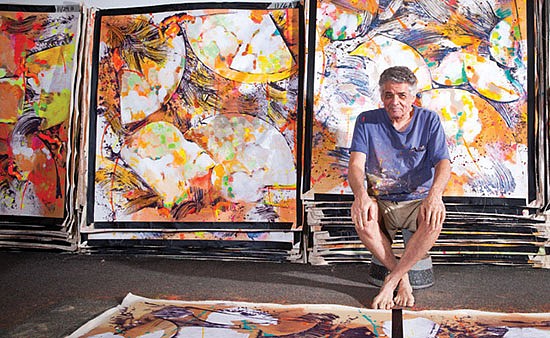
Abstract Painter Walter Darby Bannard Dies at 82
October 4, 2016 - Hamptons Art Hub Staff
American abstract painter Walter Darby Bannard died on Sunday, October 2, 2016 in Miami, announced Berry Campbell gallery. He was 82 years old. A pioneer of color field painting in the 1950s, Walter Darby Bannard (1934-2016) was committed to color-based and expressionist abstraction for over six decades.
During his undergraduate years at Princeton University, Bannard joined fellow students, the painter Frank Stella and the critic and art historian Michael Fried, in conversations that expanded aesthetic definitions and led to an emphasis on opticality as the defining feature of pictorial art. Bannard continued to explore attributes of color, paint, and surface through innovative methods, striving throughout his career for vital and original expressive means
Bannard was also a writer and served as editor for Artforum and a contributor to Art International. In the early 1990s, Bannard moved to Miami where he was a professor and head of painting at the University of Miami, Coral Gables.
A scheduled solo show of recent work by Bannard was set earlier this year at Berry Campbell gallery in Chelsea in New York. "Walter Darby Bannard: Recent Paintings" opens with a Reception on October 13, 2016 from 6 to 8 p.m. and continues on view through November 12, 2016.
Bannard was born in 1934 in New Haven, Connecticut. He attended Phillips Exeter Academy and in 1956 graduated from Princeton University. Bannard, who made drawings and watercolors throughout his youth, was self-taught as a painter. He derived inspiration for his earliest paintings from the art ofWilliam Baziotes, Theodoros Stamos and Clyfford Still.
In a 2015 interview with Franklin Einspruch for Artcritical.com, Bannard states, "That's how it is with abstract painting, it just takes you over. I remember looking at one of these little intellectual magazines when I was sixteen and I saw a de Kooning painting, and thought, wow, that's really cool."
By the late 1950s, he abandoned the sensitivity inherent in the expressionistic style, instead creating austere minimal paintings characterized by large areas of contrasting color.
In the next decade, Bannard was one of the first artists to blend artist's materials with commercially produced tinted alkyd resin house paints in a search for greater color options. In 1964, Bannard was included in the landmark exhibition, "Post-Painterly Abstraction," organized by Clement Greenberg and held at the Los Angeles County Museum of Art.
His first solo exhibitions were in 1965, held at Kasim Gallery (London); Richard Feigen Gallery (Chicago); and Tibor de Nagy Gallery (New York). Bannard was also included that year in MoMA's "The Responsive Eye." In 1968, Bannard received a Guggenheim Foundation Fellowship and a National Foundation of the Arts Award.
Over the course of his career, Bannard has had almost one hundred solo exhibitions and he has been included in an even greater number of group shows.
Throughout his career, Bannard moved between the poles of Expressionism and Color Field Painting, resulting in a body of art that has constantly evolved as the artist forthrightly faced the situations that his art presented, reacting to them with rigor and intuition.
Around 1970, Bannard's focus shifted to an exploration of the liquid quality of paint. Drawn to the new acrylic mediums that were becoming available, he began working on the floor using thick gel surfaces and color suspended in Magna or polymer mediums. During a painting workshop in Saskatchewan Canada in 1981, Bannard developed a kind of gel "drawing" on canvas, in which he applied his paint on large sheets of fiberglass, according to Berry Campbell.
By the middle of the decade, he had returned to a slower, more subtle system of marking his gel, while also returning to pouring colored polymer. He also reincorporated expressionist methods in his art.
In 1987, Bannard began his "brush and cut" paintings, consisting of large-scale canvases in which he applied transparent tinted gel with large street brooms and industrial floor squeegees to make painted "drawings," featuring vigorous brushwork and three-dimensional illusions. After moving to Miami, he incorporated more color into his large paintings, while producing small mixed-media "landscapes" on paper, inspired by the flat land and water and the lowering sun of the Florida Everglades.
Recently, Bannard increased the intensity and juxtoposition of color. The more neutral backgrounds of the past have shifted to all-over color. The surfaces of the paintings are flat and three-dimensional all at once: hot pink and fluorescent green geometric shapes appear to float above and protrude from the flat canvas. These circles reference earlier days, but added now are hard-edge trapezoids.
Flat areas of color are spiked by splatters of sparkly gels and raised areas of large sweeping brush-work creating a dance across the surface. Methods and techniques from earlier paintings are combined and used in unison in these dynamic compositions.
As recently as 2015 and 2016, Bannard continued to paint with increase vigor creating large-scale paintings up to 13 feet wide.
Bannard is represented in public collections nationally and internationally. Museum collections include Metropolitan Museum of Art, Museum of Modern Art, Whitney Museum of American Art, Solomon R. Guggenheim Museum and Brooklyn Museum (New York); Centre Georges Pompidou (Paris); Smithsonian American Art Museum (Washington, DC); Museum of Fine Arts (Boston); Albright-Knox Art Gallery (Buffalo, NY); Lowe Art Museum (Coral Gables, FL); Portland Art Museum (OR); Dallas Museum of Fine Art (TX) and many others.
Back to News
